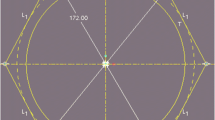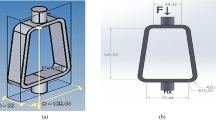Abstract
The present study discusses the effect of location of strain gauges and excitation voltage of the digital indicator over the metrological characterization of the force transducer. A trapezoidal-shaped force transducer of nominal capacity 50 kN has been investigated in which two locations for mounting the strain gauges have been identified based on FEA. The evaluation of metrological characteristics has been based on ISO 376: 2011. The relative deviations due to repeatability, reproducibility, interpolation, and expanded uncertainty of measurement has been reported in this work. A comparative analysis has been performed between the observations recorded at 5 V and 10 V excitation voltages. Results show that the effect of increased excitation voltage of the digital indicator is insignificant over the uncertainty of measurement of the force transducer. The location of strain gauges affects the sensitivity of the transducer, significantly.
Access provided by Autonomous University of Puebla. Download conference paper PDF
Similar content being viewed by others
Keywords
1 Introduction
A strain-gauged trapezoidal-shaped force transducer has been investigated in this study for force measurement in applications like onsite calibration of large testing machines to test the value of externally applied loadings, identification of materials’ strength, verification of uniaxial testing machines, calibration of hardness blocks, etc. [1, 2]. A Wheatstone bridge configuration is used for measurement of strain produced, upon applying an external unknown force. The gauge factor represents the sensitivity of the strain gauge.
Mounting of strain gauges at the maximum stress/strain positions is desirable for achieving the maximum sensitivity of SGFT [3]. In this investigation, an attempt has been made to identify the performance of SGFT by mounting the strain gauges at two different locations. Excitation voltage is another parameter which could affect the transducer’s sensitivity [4]. A comparison of metrological characterization of EN 8-based trapezoidal-shaped SGFT at 5 and 10 V excitation voltage is being discussed here.
2 Fabrication
The trapezoid geometry is machined from a EN 8 steel specimen using vertical milling machine. The dimensions are considered as follows: 180 mm outer length, 160 mm inner length, 35 mm width, and 30 mm end boss diameter [5]. The machined component is annealed at 800 °C for relieving the internal stresses. Annealing causes softening of the component. So, hardening is performed for increasing the hardness by oil quenching [6]. Surface finishing operation is performed for mounting strain gauges for force measurement [7, 8].
2.1 Mounting of Strain Gauges
The maximum stress–strain locations are selected for mounting strain gauges. Two positions are being identified in this case for examining the location-effect upon the metrological performance of the transducer [3, 9]. Strain gauges 1 and 2 are mounted orthogonally on the outer surface of the trapezoid geometry. Strain gauges 3 and 4 are mounted on the inner surface, orthogonally. These four strain gauges form a full Wheatstone bridge at Position A. Strain gauges 5, 6, 7, and 8 form another full Wheatstone bridge at Position B, as shown in Figs. 1 and 2.
3 Evaluation of Uncertainty of Measurement
The measurement result has to be stated as a magnitude value of force along with its uncertainty, including the SI unit of force. The measured force value must be linked to a reference through a recognized continual traceability chain. An essential tool in ensuring the traceability of measurement is the calibration of the force measuring instrument. Calibration establishes the performance characteristics of a transducer before its actual use [10]. Calibration in accordance to ISO 376: 2011 [11] is followed for evaluating the metrological performance of the developed force proving instrument and transducer. It is a crucial step in determining the performance characteristics of the force measurement device. The concept of uncertainty was introduced in the late 1980s. It is a statistical expression that displays the dispersion of values from the true value of the measurand [12, 13]. Following are the steps involved in evaluating UoM [14]:
-
(a)
Specification of measurand
-
(b)
Mathematical model of measurand as per ISO 376: 2011
-
(c)
Identification of sources of uncertainty
-
(d)
Evaluation of input quantities
-
(e)
Determine standard UoM of each component
-
(f)
Calculate combined standard UoM
-
(g)
Calculate expanded UoM
-
(h)
Result analysis.
SGFT has been calibrated in compression and tension for the nominal load capacity of 15 kN. The transducer has been subjected to 12% overload to the nominal capacity for 90 s four times. The overload test has been found satisfactory. 50 kN deadweight force machine has been used to calibrate the transducer following the calibration steps. The observations are recorded using a high-resolution digital indicator (10–5 mV/V) [5]. The resolution of an instrument plays a crucial role in displaying the output nearest to the true value. Higher the resolution, closest would be the output to the true value. The temperature compensation mechanism has not been included as the calibration is to be done in a controlled environment, as specified in ISO 376:2011 metrology standard. Analysis of the observations has been conducted for evaluating the UoM.
Excitation voltage of 5 V is given as an input to power the bridge initially. Three sets of observations have been recorded for a nominal tensile force of 15 kN
-
Voltage output at Position A (5 V, excitation voltage)
-
Voltage output at Position B (5 V, excitation voltage)
-
Voltage output at Position A (10 V, excitation voltage).
3.1 Metrological Characterization of EN 8 SGFT, Position A
Initially, 5 V is given to the bridge connected at Position A, and the observations are recorded for further evaluation. The relative uncertainty contribution of individual parameters is summarized in Table 1 [15, 16].
UoM is found upto 0.10% within 20–100% of the transducer’s working range. The relative uncertainty of the contributing factors is also within the permissible limits.
3.2 Metrological Characterization of EN 8 SGFT, Position B
The metrological performance evaluation of EN 8 SGFT at Position B would reveal the effect of the changed location over the metrological performance of the transducer. A summarized analysis of UoM of EN 8 SGFT at Position B has been given in Table 2.
Based on the mean values of observations at various force steps, a comparative graphical analysis is being presented in Fig. 3. It is observed that the output values are too less at Position B for the same applied force, affecting the transducer’s sensitivity.
A comparative graphical analysis of UoM of EN 8 SGFT at Position A and Position B is shown in Fig. 4. This figure depicts that the higher UoM is observed at Position B than at Position A. However, the decreasing pattern of the UoM values is identical as of Position A.
3.3 Effect of Excitation Voltage Over Metrological Characteristics of EN 8 SGFT, Position A
Excitation voltage is given as an input to the Wheatstone bridge that powers the bridge. The observations of the SGFT’s output are recorded at 5 and 10 V excitation voltage at Position A. The effect of excitation voltage over the metrology of EN 8 SGFT has been investigated based on metrological characteristics evaluation of the SGFT’s output at 10 V excitation voltage, Table 3 [4].
It has been observed that an increase in excitation voltage does not have much impact on UoM. But it has a minor effect on the mean observations. The deviation between the UoM obtained from the two excitation voltages is shown in Fig. 5.
4 Conclusion
The metrological characteristics of EN 8 SGFT have been found within the permissible limits to be applied in precision force measurement applications. The selection of the location of strain gauging affects the transducer’s sensitivity that has been concluded from an experiment performed using EN 8 SGFT. The strain gauging is performed at Position A and Position B. It is observed that the mean values of observations are less at Position B, because of the presence of low stress–strain values at this location. The effect of excitation voltage has been examined by supplying an excitation voltage of 10 V to EN 8 SGFT at Position A. A comparative graph of UoM between 5 V and 10 V excitation voltage shows that the difference between the values is insignificant.
Abbreviations
- FEA:
-
Finite element analysis
- DWFM:
-
Deadweight force machine
- SGFT:
-
Strain gauge force transducer
- zer:
-
Relative uncertainty due to zero offset
- res:
-
Relative uncertainty due to resolution
- rep:
-
Relative uncertainty due to repeatability
- rpr:
-
Relative uncertainty due to reproducibility
- int:
-
Relative uncertainty due to interpolation
- cmc:
-
Machine uncertainty
- UoM:
-
Uncertainty of measurement
- k:
-
Convergence factor
- a:
-
Parameter refers to the difference between mean and maximum values of a factor
References
Fraden J (2016) Force and strain—handbook of modern sensors. Springer, Cham. https://doi.org/10.1007/978-3-319-19303-8_10
Stefanescu DM (2011) Handbook of force transducers: principles and components. Springer Science & Business Media
Chen B, Wu X, Peng X (2007) Finite element analysis of ring strain sensor. Sens Actuators A 139:66–69
Kumar H, Kumar A (2012) Influence of excitation voltage over metrological performance of force transducers. In: XX IMEKO world congress metrology for green growth, Sept 9–14, Busan, Republic of Korea
Saxena R, Ghoshal SK, Kumar H (2021) Design, development and metrological investigation of a trapezoidal-shaped force transducer. IJPAP 59:835–844
Bhateja A, Verma A, Kashyap A (2012) Study the effect on the hardness of three sample grades of tool steel i.e., EN-31, EN-8, and D-3 after heat treatment process such as annealing, normalizing, and hardening and tempering. Int J Eng Sci 1(2):253–259
Hoffmann K (1966) Practice hints for installation of strain gauges. Hottinger Baldwin Messtechnik GmbH, HBM, pp 1–56
Stefanescu DM (2011) Strain gauges and Wheatstone bridges—basic instrumentation and new applications for electrical measurement of non-electrical quantities. In: 8th international multi-conference on systems. Signals & Devices
Kumar H, Sharma C (2012) Role of finite element analysis in improving hysteresis error of force transducers. Trans Inst Meas Control 34(8):1019–1024
Czichos H, Saito T, Smith L (2011) Springer handbook of metrology and testing, 2nd edn. Springer, London-New York
Metallic materials—calibration of force proving instruments used for verification of uniaxial testing machines. ISO 376-2004/2011
Placko D (2006) Metrology in industry—the key for quality, 1st edn. Wiley-ISTE Publisher
(2007) Uncertainty in measurement. In: Measurement uncertainty. Springer Series in Reliability Engineering. Springer, Boston, MA
Mihaiela I, Rodica R (2012) Management of uncertainty evaluation process in calibrating a force measuring device. J Electr Electron Eng 5(1):95–100
Saxena R, Ghoshal SK, Kumar H (2019) A critical assessment of simple shaped force transducers: design and metrological consideration. Indian J Pure Appl Phys 57:42–51
Kumar H, Sharma C, Kumar A, Arora PK (2015) Design, development and metrological characterization of a low-capacity precision industrial force transducer. ISA Trans 58:659–666
Author information
Authors and Affiliations
Corresponding author
Editor information
Editors and Affiliations
Rights and permissions
Copyright information
© 2024 The Author(s), under exclusive license to Springer Nature Singapore Pte Ltd.
About this paper
Cite this paper
Saxena, R., Kumar, H. (2024). Implications of Location of Strain Gauges and Excitation Voltage Over the Metrological Performance of Trapezoidal-Shaped Force Transducer. In: Shaw, R.N., Siano, P., Makhilef, S., Ghosh, A., Shimi, S.L. (eds) Innovations in Electrical and Electronic Engineering. ICEEE 2023. Lecture Notes in Electrical Engineering, vol 1109. Springer, Singapore. https://doi.org/10.1007/978-981-99-8289-9_30
Download citation
DOI: https://doi.org/10.1007/978-981-99-8289-9_30
Published:
Publisher Name: Springer, Singapore
Print ISBN: 978-981-99-8288-2
Online ISBN: 978-981-99-8289-9
eBook Packages: EnergyEnergy (R0)









